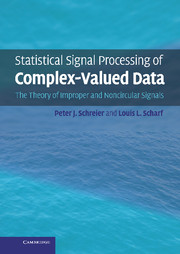Book contents
- Frontmatter
- Contents
- Preface
- Notation
- Part I Introduction
- Part II Complex random vectors
- 3 Second-order description of complex random vectors
- 4 Correlation analysis
- 5 Estimation
- 6 Performance bounds for parameter estimation
- 7 Detection
- Part III Complex random processes
- Appendix 1 Rudiments of matrix analysis
- Appendix 2 Complex differential calculus (Wirtinger calculus)
- Appendix 3 Introduction to majorization
- References
- Index
3 - Second-order description of complex random vectors
from Part II - Complex random vectors
Published online by Cambridge University Press: 25 January 2011
- Frontmatter
- Contents
- Preface
- Notation
- Part I Introduction
- Part II Complex random vectors
- 3 Second-order description of complex random vectors
- 4 Correlation analysis
- 5 Estimation
- 6 Performance bounds for parameter estimation
- 7 Detection
- Part III Complex random processes
- Appendix 1 Rudiments of matrix analysis
- Appendix 2 Complex differential calculus (Wirtinger calculus)
- Appendix 3 Introduction to majorization
- References
- Index
Summary
In this chapter, we discuss in detail the second-order description of a complex random vector x. We have seen in Chapter 2 that the second-order averages of x are completely described by the augmented covariance matrix Rxx. We shall now be interested in those second-order properties of x that are invariant under two types of transformations: widely unitary and nonsingular strictly linear.
The eigenvalues of the augmented covariance matrix Rxx constitute a maximal invariant for Rxx under widely unitary transformation. Hence, any function of Rxx that is invariant under widely unitary transformation must be a function of these eigenvalues only. In Section 3.1, we consider the augmented eigenvalue decomposition (EVD) of Rxx for a complex random vector x. Since we are working with an augmented matrix algebra, this EVD looks somewhat different from what one might expect. In fact, because all factors in the EVD must be augmented matrices, widely unitary diagonalization of Rxx is generally not possible. As an application for the augmented EVD, we discuss rank reduction and transform coding.
In Section 3.2, we introduce the canonical correlations between x and x*, which have been called the circularity coefficients. These constitute a maximal invariant for Rxx under nonsingular strictly linear transformation. They are interesting and useful for a number of reasons.
They determine the loss in entropy that an improper Gaussian random vector incurs compared with its proper version (see Section 3.2.1).
[…]
Information
- Type
- Chapter
- Information
- Statistical Signal Processing of Complex-Valued DataThe Theory of Improper and Noncircular Signals, pp. 61 - 84Publisher: Cambridge University PressPrint publication year: 2010
